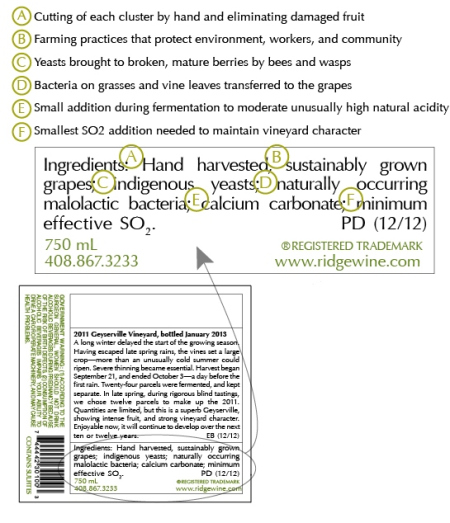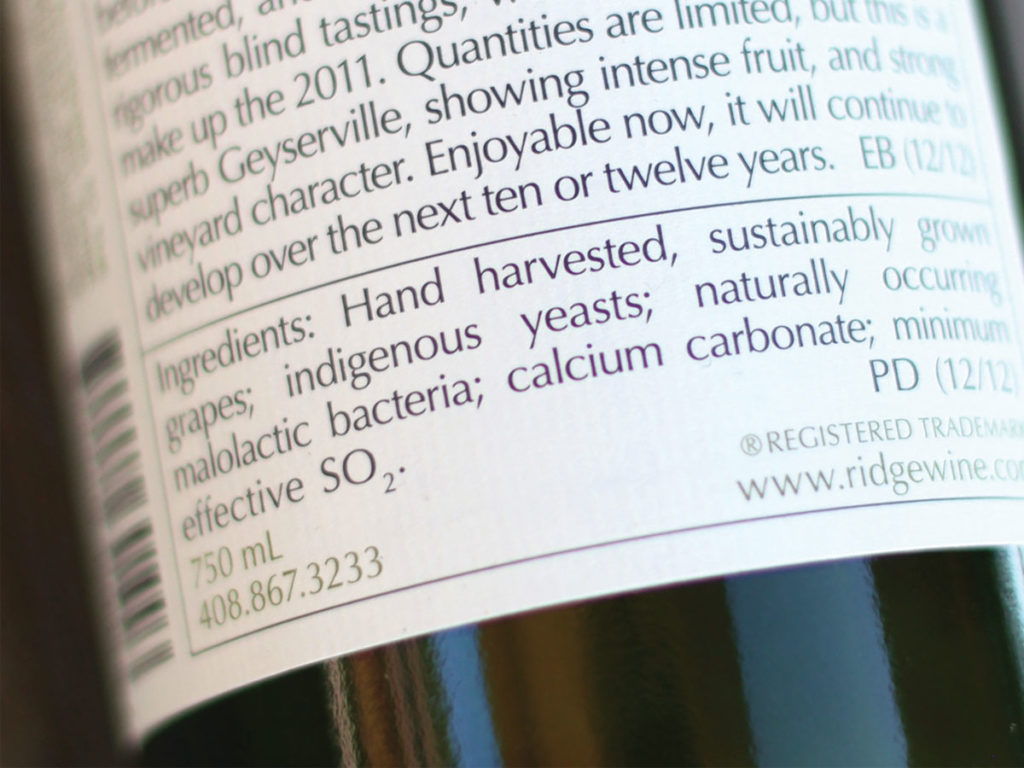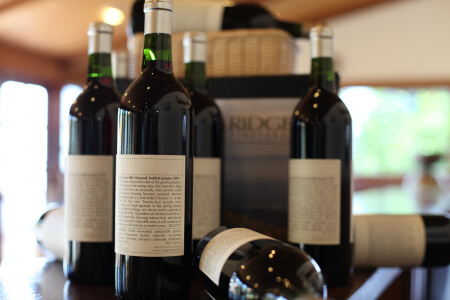Ingredient Labeling and Transparency in Our Wine
Blog Post
If you’ve ever had a bottle of Ridge Vineyards Wine, you know that you can find a full list of ingredients on its back label.
Years ago, Ridge Vineyards elected to include an ingredients list on all its labels. Paul Draper explained at the time:
“At Ridge we call our approach to winemaking ‘pre-industrial.’ We believe that for anyone attempting to make fine wine, modern additives and invasive processing limit true quality and do not allow the distinctive character of a fine vineyard to determine the character of the wine.
“Ridge is adding to its labels a list of actions and ingredients to demonstrate how little intervention is necessary to produce a fine, terroir-driven wine from distinctive fruit.”
To learn more, watch the video below:
Additives in US Wine Vs. Ridge Wine
Currently, the TTB (Alcohol and Tobacco Tax and Trade Bureau) has approved over 60 different additives for use in wine. Want to see all the additives currently approved? Click here to review the TTB’s website.
Then, compare that with the ingredient list on a Ridge Vineyards label:

Letters A-B are pretty straightforward; not a great deal being done by us in the way of invasion or manipulation. We point out the methods by which we harvest our grapes, in the spirit of transparency, and because we are proud of our efforts in sustainability. For Ridge, we define sustainability like this:
“A system that is sensitive to the environment, responsible to the community, and economically feasible to implement and maintain. These three principles provide a framework and direction to guide our decision-making. Sustainability is an ever-changing target, even a state of mind: improvements can always be made to lessen one’s impact on the planet.”
These sustainable growing methods include integrated pest management, beneficial crop cover, organic farming, and sap flow monitoring.
Items C and D are similar: What’s needed is already there. We rely on that, and nothing more.
But E, calcium carbonate, is a true addition. So just how invasive is it? If you go back to that TTB list of approved additives, calcium carbonate is one of very few items without a restriction associated with it. This is because it’s harmless and is used to settle the acid within the wine.

Finally, F, the SO2. The matter of SO2 is probably one of the most misunderstood issues in the contemporary world of wine. To help clarify the language of F, we use the “Smallest SO2 addition needed to maintain vineyard character.“
What does that mean? How much is smallest, and how does that maintain character?
Monte Bello winemaker and COO Eric Baugher answered the question of how much:
“The winery team adds 30-35 ppm of SO2 to the must (at crush) to select for native Saccharomyces and limit the growth of bacteria that could spoil malolactic fermentation.
“To reduce the risk of oxidizing or spoiling the wine, the winery team adds small amounts of SO2 before crush, immediately following the completion of malolactic fermentation and during each quarterly racking thereafter.”
According to Baugher, a small dose of sulfur dioxide is 5-10 ppm. For him, the amount of SO2 depends on pH and residual sugar-aldehyde formation produced by any in-barrel springtime fermentation.
The important thing to note is this: ppm stands for parts-per-million. Meaning, 30-35 ppm is not a large number. The total SO2 allowed in wine in the US is 350 ppm, and in the EU it is 160 ppm (for red wines). So, 30-35ppm is much lower the the standard or requirement.
So why add it at all? This is where the “maintain vineyard character” part comes in. Paul Draper answered this question, replying:
“The difference of opinion over natural wine often occurs over the use of SO2. Of course we have the problem that EU regulations allow an addition of 100ppm and US regulations allow 0ppm addition for ‘organic’ wine. That problem is really beside the point as an addition of 10ppm in virtually every case is insufficient to keep the natural process on the proverbial straight and narrow in order that the wine will consistently express the distinct character and quality of its site. Of course that presupposes that the site is sufficiently good terroir to provide that character and quality in the first place. My experience of growing fine wine and of tasting wines made with 0ppm to 10ppm is that unless the minimum effective level of SO2 is used the wines will not consistently express terroir. Given that, that expression or the attempt at that expression is essential to what I love about wine- we carefully analyze the wine to determine that effective minimum level.”
In summary: at Ridge, we add just enough SO2 to prevent anything changing the flavor of the wine, as opposed to adding SO2 specifically to change the flavor of the wine.
And that is the A to F of a Ridge label. However, if you’re ever looking to learn more about a particular wine, we provide additional resources on that corresponding wine’s page on our website. This includes information on the winemaking process for that particular wine, vineyard information, vintage information, accolades, and more.

Winemakers on Labeling and Transparency
Ridge winemaker Eric Baugher wrote the following, in regards to additives and ingredient labeling:
“We feel, by listing our ingredients, we can bring the issue into the consciousness of consumers. Not that we want to make enemies in the industry, or attack any wineries for what they might add to their wines, we are looking to consumers to become more knowledgeable about these additives and practices by volunteering this information on our labels. If they begin to make their purchasing decisions based on the level of purity of the wines they drink, then it possibly could have an effect on making those wineries think twice before they add something.”
And in a letter Paul Draper wrote on the matter, he said:
“We refer to winemaking at Ridge as ‘pre-industrial’ – an approach that involves the use of native yeasts, hand-harvested, sustainably grown grapes, naturally occurring malolactic bacteria, and a small number of natural ingredients used in making fine wine over the last two hundred years. We are hoping to encourage other fine-wine makers to provide a list of ingredients for their customers.”
If you haven’t seen it before, Ridge currently defines the concept of Pre-Industrial Winemaking as follows:
“Pre-industrial winemaking begins with respect for the natural process that transforms fresh grapes into wine, and the 19th-Century model of minimum intervention. When you have great vineyards that produce high quality grapes of distinctive individual character, this is not only an environmentally and socially responsible approach, it’s also the best way to consistently make fine wine.”
In the end, we strive to produce excellent wine for our consumers. We want our wine to be healthy and safe. We want it to taste good. We want it to be unique. And we want it to be honest.
Wait!
In order to qualify for user related discounts, you must log in before proceeding with checkout. Click the button below to log in and receive these benefits, or close the window to continue.
Log In